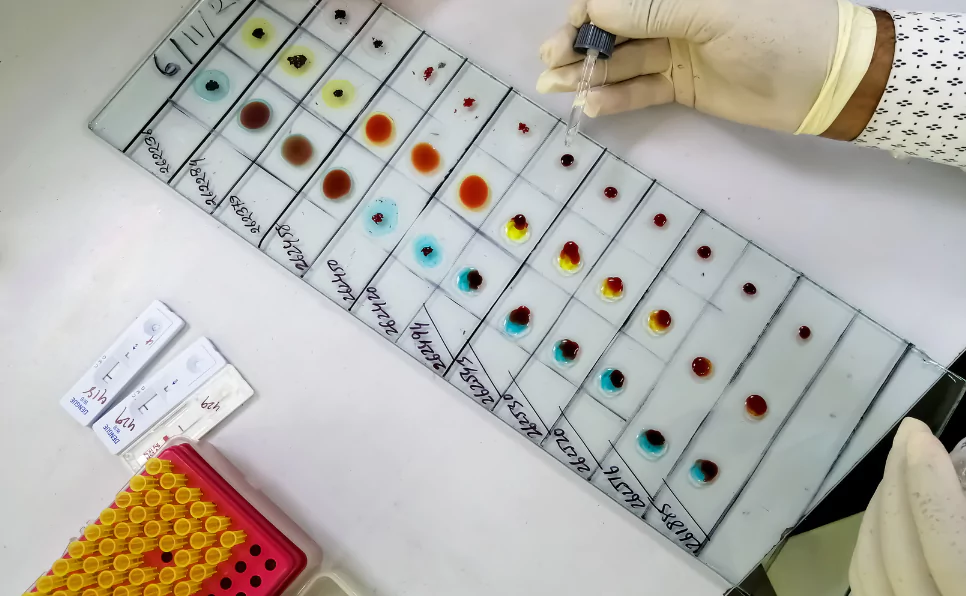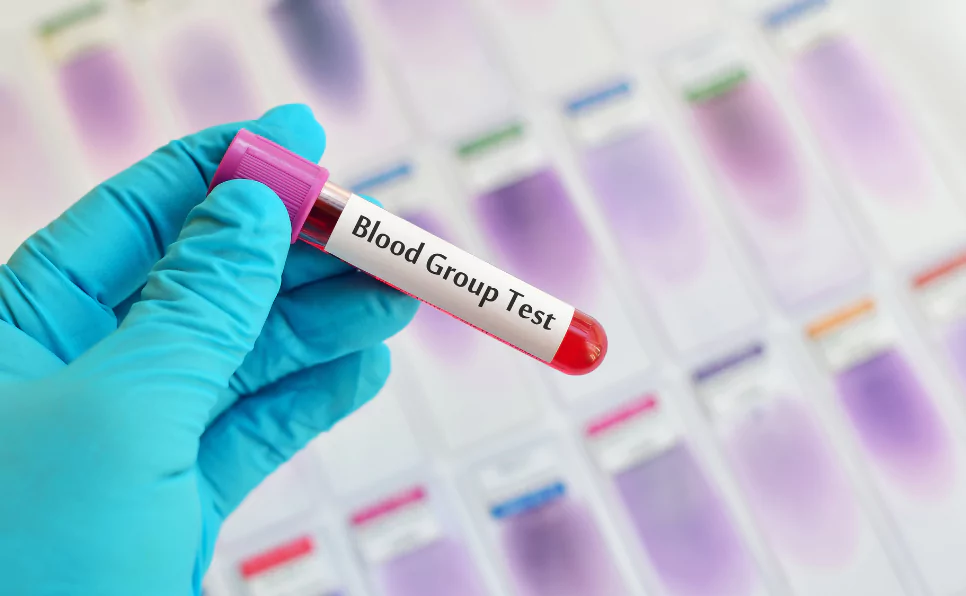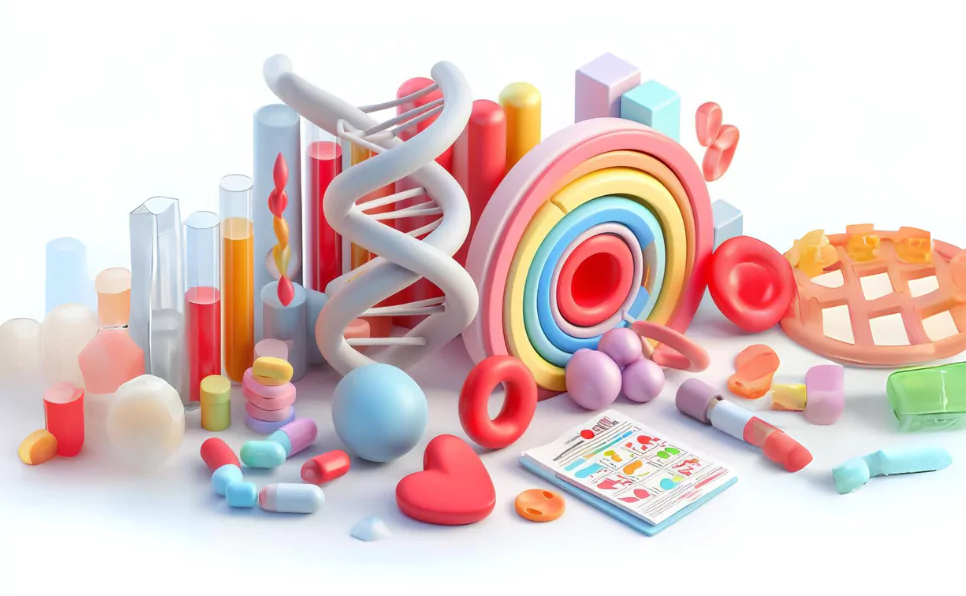Have you ever thought about why people have different blood types? Or why knowing your blood type is key for health, like when getting a blood transfusion? This article takes you into the interesting world of blood type genetics.
Blood type is a method of grouping your blood based on specific molecules on your red blood cells’ surface.
There are two primary systems for classifying blood types: the ABO system and the Rh system.
The ABO system includes four types of antigens: A, B, AB, and O. The Rh system depends on whether a protein, the Rh factor, is present or not.
Combining these systems, we get eight usual blood types: A+, A-, B+, B-, AB+, AB-, O+, and O-. Each of these blood types has a different distribution across populations but AB negative is the rarest of all found in just 1% of the global population.
In the following sections, we’ll dive into how the genes determine your blood type and how that matters.
The Basics of Blood Type Genetics
So, how do you end up with your specific blood type? It’s all about your genes.
Genes are parts of DNA that hold the blueprints for making proteins and other important molecules in your body. You get two versions of each gene, one from your mom and one from your dad.
The mix of these genes decides many of your characteristics, such as eye color, hair color, and blood type.
ABO Blood Group System: The Key to Blood Type Genetics
Blood types are mainly categorized using the ABO system. This revolves around the presence of A and B antigens on your red blood cells.
Antigens are substances that can trigger your immune system to produce antibodies.
In the ABO group blood system, there are four blood types: A, B, AB, or O.
This is decided by the ABO gene, which has three forms: A, B, and O.
The ABO gene, residing on chromosome 9, produces an enzyme that adds specific sugars to the H antigen on red blood cells.
The ABO gene variants add different sugars, with A adding N-acetylgalactosamine (for the A marker), B adding galactose (for the B marker), and O not adding any sugar, resulting in no markers.
The type of sugar added determines whether your blood cells have A, B, both A and B, or no antigens, as shown in the table below:
| Blood Type | Antigens on Red Blood Cells |
|---|---|
| A | A only |
| B | B only |
| AB | A and B |
| O | None |
For instance, inheriting an A form from one parent and a B from another gives you blood type AB. Two O forms result in blood type O.
The table below shows the possible combinations:
| Genotype | Blood Type |
|---|---|
| AA or AO | A |
| BB or BO | B |
| AB | AB |
| OO | O |
Predicting Blood Types from Genetics
Your blood type comes from the combination of ABO gene variants you inherit. A Punnett square, a chart used to predict genetic combinations, can help illustrate this.
For example, if one parent has the AO combination (Type A) and the other has BO (Type B), their children could have AB, A, B, or O blood types, each with a 25% chance.
The table below shows a Punnett square for this scenario:
| Parent 1 (AO) | Parent 2 (BO) | Possible Blood Types |
|---|---|---|
| A | B | AB |
| A | O | A |
| O | B | B |
| O | O | O |
The following tables illustrate how blood type genotypes are determined by the combinations of parental alleles:
Blood Type Genotypes:
| Parent 1 Blood Type | Parent 2 Blood Type | Possible Blood Type of Child |
|---|---|---|
| A (AO or AA) | B (BO or BB) | A, B, AB, O |
| A (AO or AA) | O (OO) | A, O |
| B (BO or BB) | O (OO) | B, O |
| AB (AB) | O (OO) | A, B |
| AB (AB) | AB (AB) | A, B, AB |
| O (OO) | O (OO) | O |
Here is a simplified calculator considering parent ABO blood group and Rh factor to predict what will be child blood group.
Blood Type Calculator
This is how blood typing and genetics intertwine, showing how your unique blood type is a direct result of your genetic heritage.
Rh Blood Typing and Genetics: Another Crucial Aspect
The Rh system is another vital part of blood typing. It’s about the Rh factor, an antigen on your red blood cells, controlled by the RHD gene.
This gene has two forms: positive and negative. The positive is dominant. If you have two negative forms, you’re Rh negative.
With at least one positive form, you’re Rh positive.
The Rh system, named after the rhesus monkey used in its discovery, is significant in blood transfusions and pregnancy, as mismatches in the Rh factor can cause immune reactions.
Here are Rh Factor Genotype possible inheritances:
| Parent 1 Rh Factor | Parent 2 Rh Factor | Possible Rh Factor of Child |
|---|---|---|
| Positive (+) | Positive (+) | Positive (+), Negative (-) |
| Positive (+) | Negative (-) | Positive (+), Negative (-) |
| Negative (-) | Negative (-) | Negative (-) |
Understanding the ABO and RHD genes gives us eight blood types: A+, A-, B+, B-, AB+, AB-, O+, or O-.
Blood Types Around the World
Different parts of the world have different common blood types. This variety comes from our history – things like where our ancestors lived, who they mixed with, and what diseases were around.

For example, the O type is common in indigenous groups in the Americas and Australia, while B is more common in Central Asia and Northern India.
A is often seen in Europe and some parts of Africa. The AB type is quite rare globally.
| Country/Region | O+ | A+ | B+ | AB+ | O- | A- | B- | AB- |
|---|---|---|---|---|---|---|---|---|
| USA | 37.4% | 35.7% | 8.5% | 3.4% | 6.6% | 6.3% | 1.5% | 0.6% |
| China | 29.9% | 27.4% | 24.6% | 9.8% | 0.3% | 0.3% | 0.4% | 0.1% |
| India | 33.1% | 22.1% | 32.5% | 7.5% | 0.5% | 0.4% | 0.6% | 0.2% |
| Japan | 30.1% | 38.8% | 13.2% | 7.0% | 0.3% | 0.3% | 0.2% | 0.1% |
| UK | 36.5% | 35.7% | 8.4% | 3.3% | 7.0% | 6.4% | 1.4% | 0.9% |
| Nigeria | 51.3% | 22.8% | 18.7% | 3.8% | 1.8% | 0.9% | 0.6% | 0.1% |
AB is generally rare but more frequent in Central Asia and parts of Europe.
Rh negative is more found in Europe, especially Spain and France, while Rh positive is more common in Africa and Asia.
The Rh factor varies in different populations. For example, in the U.S., about 85% of people have positive blood types.
This percentage changes with different ethnic backgrounds. In Asian populations, 99% are positive, while in some European regions, like the Basque Country, the negative blood type is more common.
These blood type distributions show the genetic interactions and adaptations of human populations to their environments and diseases.
For example, blood type O might offer some resistance against malaria, while A might increase gastric cancer risk.
However, more research is necessary to confirm these findings and understand the underlying reasons.
Rarest Rh-null Blood Group Also Called Golden Blood
Rh-null is nicknamed “golden blood” because it’s incredibly rare, just like gold. This blood type is so special because it doesn’t have any antigens in the Rh system.
Antigens are substances that can trigger an immune response if they’re foreign to the body. Since Rh-null blood lacks these Rh antigens, it can be a universal donor for the rare individuals who need it, making it extremely valuable.
Why Is Rh-null Blood So Important?
- Scarce: With fewer than 50 people worldwide having this blood type, finding donors is like finding a needle in a haystack.
- Universal Donor Capabilities: Rh-null blood can be given to people with rare blood types who often struggle to find compatible donors.
- Medical Research: Scientists study Rh-null to learn more about blood types and how they affect health.
- Life-Saving: For those few people with Rh-null blood or other rare types, having access to it can be life-saving.
Why Does Your Blood Type Matter?
Your blood type can influence your health in several ways. It might change your risk for certain diseases, affect how you handle infections, and even impact your diet and pregnancy.
Some examples:
- Disease Risks: Different blood types have been linked with different health risks. For instance, Type A might be more prone to stomach cancer and diabetes, while Type O could be less likely to have heart disease but more likely to get ulcers. Type AB might have higher risks for stroke and memory issues, and Type B might be more susceptible to pancreatic cancer and urinary infections. These links aren’t set in stone and can be influenced by many factors.
- Blood Transfusions: The most immediate application is in blood transfusions. Knowing the blood type of both the donor and the recipient is vital to avoid potentially life-threatening reactions. If someone receives the wrong blood type, their immune system may attack the donor blood cells, leading to serious complications.
- Organ Transplants: Like blood transfusions, organ transplants require compatibility between donor and recipient. Blood type is one of the key factors considered to ensure that the recipient’s body does not reject the transplanted organ.
- Infection Response: Your blood type can affect how you deal with infections. For example, Type O people might be less likely to get severe malaria, as the parasite struggles to latch onto their blood cells.
- Food Digestion: There’s a theory called the blood type diet, suggesting that your blood type affects what foods are best for you. However, there’s no solid scientific backing for this idea.
- Pregnancy Complications: If you’re Rh-negative and your baby is Rh-positive, it can lead to complications. If a mother is Rh- and her baby is Rh+, there’s a risk of hemolytic disease of the newborn (HDN). This is because your body might see the baby’s Rh-positive cells as foreign.
In summary, blood types and genetics are fascinating and complex.
The ABO blood group system is a vital part of our genetic makeup, influencing not only our blood type but also potentially our health and the way we respond to various external factors.
Understanding this system can provide insights into our genetic heritage and how it impacts our daily lives.
Exploring More Than ABO and Rh: The Diversity of Blood Type Genetics
When we think of blood types, the ABO and Rh blood groups often come to mind, as they are crucial for safe blood transfusions and pregnancy.
Yet, the world of blood type genetics is much more diverse, encompassing numerous other blood group systems that play significant roles in our health and ancestry.
There are lesser-known blood group systems like Kell, Duffy, Lewis, and MN, highlighting their genetic foundations and implications for our well-being.
Kell Blood Group System
The Kell system revolves around a protein, Kell, on red blood cell surfaces. There are two primary Kell antigens, K and k, inherited from our parents.
The K antigen is rarer, found in 9% of Caucasians, 2% of Africans, and 1% of Asians. Conversely, the k antigen is widespread, appearing in over 99% of people.
If someone has the K antigen, they can develop antibodies against the k antigen, and vice versa.
These antibodies may lead to hemolytic transfusion reactions, where donated blood cells are attacked by the recipient’s immune system, or hemolytic disease of the newborn, where a mother’s antibodies harm the baby’s blood cells.
The Kell system is also linked to McLeod syndrome, affecting the nervous system and muscles.
This syndrome arises from a mutation in the XK gene connected to the KEL gene on the X chromosome, leading to low Kell antigen levels and potential blood clotting and infection issues.
Duffy Blood Group System
Duffy antigens, Fya and Fyb, found on red blood cells and other body cells, are determined by a gene on chromosome 1.
Fya is more prevalent in Caucasians and Asians, while Fyb is more common in Africans.
People without Fya and Fyb antigens, termed Duffy negative, show resistance to Plasmodium vivax malaria, as Duffy proteins serve as entry points for this parasite in red blood cells.
This trait is mainly found in Africa, a malaria-endemic region.
The Duffy system also influences our response to chemokines, molecules involved in inflammation and immunity, potentially impacting the risk and severity of diseases like HIV, asthma, and cancer.
Lewis Blood Group System
The Lewis system involves fucose, a sugar attached to proteins and lipids on red blood cells and other cells.
Two key Lewis antigens, Lea and Leb, are produced by genes on chromosome 19. These genes code for enzymes that add fucose to molecules, creating these antigens.
Interlinked with the ABO and secretor systems, the Lewis system influences our body’s interaction with bacteria like Helicobacter pylori, which can lead to ulcers and gastritis.
It may also affect the risk of cardiovascular disease, rheumatoid arthritis, and urinary infections.
MN Blood Group System
The MN system is based on glycophorin A protein on red blood cells, with two main antigens, M and N, differing by a single amino acid.
Determined by a gene on chromosome 4, this system shows substantial variation among populations, aiding in genetic and anthropological research.
Though clinically insignificant, the MN system is crucial for studying the red blood cell membrane, influencing its shape, flexibility, and lifespan, and may affect susceptibility to infections like malaria and influenza.
All these diverse blood group systems, governed by genetics, are pivotal in medical science. Understanding them deepens our insight into human health and history, aiding in disease prevention and treatment.
Genetic Anomalies in Blood Types
While most people have standard blood types following predictable patterns of blood type heredity, there exist rare genetic anomalies that can create unique and complex blood types.

Here we will discuss four such rare conditions: chimerism, Bombay blood group, cis AB blood type, and weak D phenotype, which are significant in understanding the genetics of blood type and blood type genetics.
Chimerism
Chimerism is a fascinating genetic condition where an individual possesses two or more different sets of DNA.
This can occur from the fusion of two fertilized eggs early in development, or post-birth through blood transfusions or transplants.
This genetic mixing can lead to a person having a mix of blood types, potentially causing discrepancies with family blood typing and genetics and complicating transfusions.
Chimerism, while rare and often symptomless, can sometimes be identified through distinct physical traits or genetic testing, and it plays a crucial role in the study of blood grouping genetics and blood type heredity.
Bombay Blood Group
The Bombay blood group stands out due to the absence of the H antigen, the foundation for A and B antigens.
People with this group have no A, B, or H antigens, making blood transfusions extremely challenging, as they can only receive blood from those with the same rare type.
This group results from mutations in the FUT1 gene, crucial in blood type genetics.
Mistaking it for the O blood type can have dire consequences, as it shares some similarities but has distinct differences crucial in blood transfusion compatibility.
Cis AB Blood Type
The cis AB blood type is a rare genetic condition caused by a unique mutation in the ABO gene, responsible for blood type determination.
This mutation creates a hybrid enzyme capable of producing both A and B antigens from a single allele, differing from the typical separate A and B alleles.
This blood type, predominantly found in certain Asian regions, presents unique inheritance patterns and blood transfusion compatibility, making it a significant topic in blood type genetics and blood typing and genetics.
Weak D Phenotype
The weak D phenotype involves a lower expression of the RhD antigen, pivotal in the Rh blood group system.
Variations in the RHD gene can lead to this phenotype, affecting the antigen’s structure and abundance.
This condition, more common in some populations than others, has implications for blood transfusions and Rh compatibility in pregnancy.
Understanding the weak D phenotype is crucial in the realm of blood type genotype and genetics blood type studies.
All these genetic anomalies in blood types highlight the complexity of blood type genetics and the importance of understanding blood type hereditary patterns.
They underscore the intricate relationship between genotypes for blood types and how blood types are determined, revealing the depth of blood grouping genetics.

Final Words On Genetics of Blood Types
In this article, we delve into the intriguing relationship between genetics and blood types.
Understanding blood types is vital, particularly for blood transfusion, a critical medical procedure involving the transfer of blood from a donor to a recipient.
However, compatibility is key; mismatched blood types can lead to severe immune reactions. This necessity highlights the importance of blood type heredity and compatibility in transfusion medicine.
Blood type distribution varies globally, with some types more prevalent or in demand than others, affecting blood donation and transfusion strategies worldwide.
Beyond medical relevance, blood types hold genetic significance, mirroring our ancestry and evolutionary journey. Blood type hereditary patterns show that the O type, the oldest and most widespread, is predominant among individuals of African, Asian, and Native American descent.
The A type, associated with European and Middle Eastern lineages, is believed to have evolved alongside agricultural societies.
The B type, more common in Asian and African populations, likely originated in Asia, spreading through migration and intermarriage.
The AB type, the newest and rarest, is frequently seen in people of mixed heritage.
In summary, the study of blood type genetics offers deep insights into health, history, and societal dynamics, highlighting the critical role of genes in determining blood types.
References:
- World Population By Percentage of Blood Types – WorldAtlas
- Blood Types: What They Are and Mean for Your Health – Cleveland Clinic
- How to Find Out Your Blood Type Easily – Blood Type Chart & Facts – Good Housekeeping
- Blood types: What are they and what do they mean? – Medical News Today
- Chart: The Blood Type Distribution Around The World | Statista
- How is blood type inherited? And do exceptions ever happen? – The Tech Interactive
- Genes and Blood Type – University of Utah
- How Blood Types Work | OneBlood
- Human genetics – Blood Types, Traits, Disorders | Britannica
- Genetics of blood type: inheritance and compatibility – Medicover Genetics
- The distribution of blood types by country – The DO Loop – SAS Blogs
- Visualizing The Most Widespread Blood Types in Every Country – Visual Capitalist
- What Is The Rh Factor? Why Is It Important? – Red Cross Blood
- Rh factor blood test – Mayo Clinic
- Kell antigen system – Wikipedia
- Kell blood group system | Genetics, Antigens, Inheritance – Britannica
- Duffy blood group system | Genetics, Antigens & Blood Types – Britannica
- Lewis antigen system – Wikipedia
- Lewis blood group system | Antigens, Genes, Inheritance – Britannica
- MNS antigen system – Wikipedia
- MNSs blood group system | Genetics, Antigens & Rh Factor – Britannica
- Chimerism: Definition, Symptoms, Testing, Diagnosis, and More – Healthline
- Blood safety and availability – World Health Organization (WHO)
- Blood Safety Basics | CDC – Centers for Disease Control and Prevention

Dr. Sumeet is a seasoned geneticist turned wellness educator and successful financial blogger. GenesWellness.com, leverages his rich academic background and passion for sharing knowledge online to demystify the role of genetics in wellness. His work is globally published and he is quoted on top health platforms like Medical News Today, Healthline, MDLinx, Verywell Mind, NCOA, and more. Using his unique mix of genetics expertise and digital fluency, Dr. Sumeet inspires readers toward healthier, more informed lifestyles.





